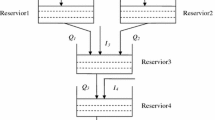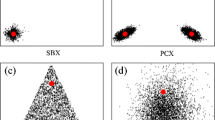Abstract
This article presents a novel framework of nondominated sorting-based disruption in oppositional gravitational search algorithm (NSDOGSA) for solving an inventive stochastic multiobjective short-term hydrothermal scheduling (SMSHTS) problems. An innovative SMSHTS mathematical formulation is derived in terms of stochastic objective functions subject to stochastic hydro- and thermal constraints. Also, a versatile constraint handling procedure is proposed to satisfy all the constraints. Besides, an opposition-based learning perception is assimilated in a gravitational search algorithm (GSA) to explore the excellence of the present population and disruption operator is integrated to hasten the convergence of solutions. Moreover, a nondominated sorting procedure is hybridized to attain a set of nondominated solutions for SMSHTS problems. In addition, an elite external archive is created to keep the nondominated solutions with the help of spread indicator and also to guide the search process toward global optima. Further, a fuzzy decision making is employed for selecting the best trade-off solution among the nondominated solution set. Finally, the proposed NSDOGSA approach is validated on four test systems that consist of two fixed-head and two variable-head stochastic multiobjective hydrothermal scheduling problems. Thus, the obtained simulation results are found to be better in terms of objective function values as well to satisfy constraints compared to other methods within a reasonable execution time.



Similar content being viewed by others
References
Agarwal SK (1973) Optimal stochastic scheduling of hydrothermal systems. IET Proc Generat Transm Distrib 120(6):674–678
Ahmadi A, Kaymanesh A, Siano P, Janghorbani M, Nezhade AE, Sarno D (2015) Evaluating the effectiveness of normal boundary intersection method for short-term environmental/economic hydrothermal self-scheduling. Electr Power Syst Res 123:192–204
Basu M (2004) An interactive fuzzy satisfying method based on evolutionary programming technique for multi-objective short-term hydrothermal scheduling. Electr Power Syst Res 69(3):277–285
Basu M (2011) Economic environmental dispatch of fixed head hydrothermal power systems using nondominated sorting genetic algorithm-II. Appl Soft Comput 11:3046–3055
Chunlong L, Jianzhong Z, Peng L et al (2015) Short-term economic environmental hydrothermal scheduling using improved multi-objective gravitational search algorithm. Energy Convers Manag 89:127–136
Coello CAC, Pulido GT, Lechuga MS (2004) Handling multiple objectives with particle swarm optimization. IEEE Trans Evolut Comput 8(3):256–279
Deb K, Amrit P, Sameer A et al (2002) A fast and elitist multi-objective genetic algorithm: NSGA-II. IEEE Trans Evolut Comput 6(2):182–197
Deng W, Chen R, Gao J, Song Y, Xu J (2012a) A novel parallel hybrid intelligence optimization algorithm for function approximation problem. Comput Math Appl 63(1):325–336
Deng W, Chen R, He B, Liu Y, Yin L, Guo J (2012b) A novel two-stage hybrid swarm intelligence optimization algorithm and application. Soft Comput 16(10):1707–1722
Deng W, Yang X, Zou L, Wang M, Liu Y, Li Y (2013) An improved self-adaptive differential evolution algorithm and its application. Chemom Intell Lab Syst 128:66–76
Deng W, Zhao H, Liu J, Yan X, Li Y, Yin L, Ding C (2015) An improved CACO algorithm based on adaptive method and multi-variant strategies. Soft Comput 19(3):701–713
Deng W, Yao R, Zhao H, Yang X, Li G (2017a) A novel intelligent diagnosis method using optimal LS-SVM with improved PSO algorithm. Soft Comput. https://doi.org/10.1007/s00500-017-2940-9
Deng W, Zhao H, Yang X, Xiong J, Sun M, Li B (2017b) Study on an improved adaptive PSO algorithm for solving multi-objective gate assignment. Appl Soft Comput 59:288–302
Deng W, Zhao H, Zou L, Li G, Yang X, Wu D (2017c) A novel collaborative optimization algorithm in solving complex optimization problems. Soft Comput 21(15):4387–4398
Dhillon JS, Parti SC, Kothari DP (2002) Fuzzy decision-making in stochastic multi objective short-term hydrothermal scheduling. IET Proc Generat Transm Distrib 149(2):191–200
Dhillon JS, Dhillon JS, Kothari DP (2011) Real coded genetic algorithm for stochastic hydrothermal generation scheduling. J Syst Sci Syst Eng 20(1):87–109
Gouthamkumar N, Sharma V, Naresh R (2015a) Disruption based gravitational search algorithm for short term hydrothermal scheduling. Exp Syst Appl 42:7000–7011
Gouthamkumar N, Sharma V, Naresh R (2015b) Hybridized gravitational search algorithm for short term hydrothermal scheduling. IETE J Res 62(4):1–11
Gouthamkumar N, Sharma V, Naresh R (2016a) Nondominated sorting disruption based gravitational search algorithm with mutation scheme for multiobjective short term hydrothermal scheduling. Elec Power Comput Syst 52(7):1–15
Gouthamkumar N, Sharma V, Naresh R (2016b) Application of nondominated sorting gravitational search algorithm with disruption operator for stochastic multiobjective short term hydrothermal scheduling. IET Generat Transm Distrib 10(4):862–872
Guo Z, Yue X, Yang H, Liu K, Liu X (2017) Enhancing social emotional optimization algorithm using local search. Soft Comput 21(24):7393–7404
Li C, Zhou J, Lu P, Wang C (2015) Short-term economic environmental hydrothermal scheduling using improved multi-objective gravitational search algorithm. Energy Convers Manag 89:127–136
Mirjalili S, Gandomi AH (2017) Chaotic gravitational constants for the gravitational search algorithm. Appl Soft Comput 53:407–419
Nanda J, Bijwe PR, Kothari DP (1986) Application of progressive optimality algorithm to optimal hydrothermal scheduling considering deterministic and stochastic data. Int J Electr Power Energy Syst 8(1):61–64
Rashedi E, Nezamabadi-pour H, Saryazdi S (2009) GSA: a gravitational search algorithm. Inf Sci 179(13):2232–2248
Sun C, Lu S (2010) Short-term combined economic emission hydrothermal scheduling using improved quantum-behaved particle swarm optimization. Exp Syst Appl 37(6):4232–4241
Tian H, Yuan X, Ji B, Chen Z (2014) Multi-objective optimization of short-term hydrothermal scheduling using non-dominated sorting gravitational search algorithm with chaotic mutation. Energy Conver Manag 81:504–519
Tian H, Yuan X, Huang Y et al (2015) An improved gravitational search algorithm for solving short-term economic/environmental hydrothermal scheduling. Soft Comput 19(10):2783–2797
Umayal SP, Kamaraj N (2005) Stochastic multi objective short term hydrothermal scheduling using particle swarm optimization. In: India council international conference, pp 497–501
Wu M, Li K, Kwong S, Zhou Y, Zhang Q (2017) Matching-based selection with incomplete lists for decomposition multiobjective optimization. IEEE Trans Evolut Comput 21(4):554–568
Xue F, Sanderson AC, Graves RJ (2003) Pareto-based multi-objective differential evolution. IEEE Trans Evolut Comput 2:862–869
Zhang H, Zhou J, Zhang Y, Lu Y, Wang Y (2013) Culture belief based multi-objective hybrid differential evolutionary algorithm in short term hydrothermal scheduling. Energy Convers Manag 65:173–184
Zitzler E, Laumanns M, Thiele L (2001) SPEA2: improving the strength Pareto evolutionary algorithm. Technical report TIK-report 103. Swiss federal institute of technology, Zurich, Switzerland
Author information
Authors and Affiliations
Corresponding author
Ethics declarations
Conflict of interest
The authors declare that they have no conflict of interest.
Additional information
Communicated by V. Loia.
Appendices
Appendices
1.1 Appendix 1: Derivation for stochastic production cost with valve point effect
Let us consider \( X \) is a random variable and the expected value, also called as mean value of this random variable \( X \) is defined as \( E\left( X \right) \) or \( \bar{X} \). If \( \bar{X} \) is an expected value of \( X \) and variance \( \sigma^{2} \) and \( X = \bar{X} + \Delta X, \) with \( \overline{\Delta X} \) = 0 and \( \overline{{\Delta X^{2} }} = \sigma^{2} , \), then a nonlinear function \( f\left( X \right) \) can be written using Taylor series expansion about \( \bar{X} \) as
and expected value of \( f\left( X \right) \) is given as
The deterministic non-convex production cost function of thermal generating units with valve point loading effect is usually represented as:
where \( EPC \) is economical production cost, \( Ng \) is number of thermal plants, \( T \) is total scheduled intervals, \( P_{i}^{t} \) is ith unit thermal generation at tth time interval, \( P_{i}^{\hbox{min} } \) is lower thermal generation capacity limit of ith plant, and \( a_{i} ,b_{i} ,c_{i} ,d_{i} ,e_{i} \) are ith thermal plant cost coefficients.
The stochastic non-convex production cost function \( \bar{f}_{1} \,\,\,{\text{or}}\,\,\,\,\overline{EPC} \) of thermal plants in terms of \( f_{1} \left( {\bar{P}_{i}^{t} } \right) \) and \( f_{1}^{\prime \prime } \left( {\bar{P}_{i}^{t} } \right) \), using Eqs. (32) and (33), can be expressed as follows:
Thus, by using the above Eqs. (34) and (35), the expected production cost with valve point loading effect is expressed as follows:
1.2 Appendix 2: Derivation for stochastic environmental emission pollution function
The deterministic emission pollution function of thermal generating units is usually represented as:
where \( EEP \) is environmental emission pollution, and \( \alpha_{i} ,\beta_{i} ,\gamma_{i} ,\eta_{i} ,\delta_{i} \) represents ith thermal plant of emission pollution coefficients. The stochastic emission function \( \bar{f}_{2} \,\,\,{\text{or}}\,\,\,\overline{EEP} \) of thermal plants in terms of \( f_{2} \left( {\bar{P}_{i}^{t} } \right) \) and \( f_{2}^{\prime \prime } \left( {\bar{P}_{i}^{t} } \right) \), using Eqs. (37) and (38) can be expressed as follows:
Thus, by using the above Eqs. (38) and (39), the expected emission function is expressed as follows:
1.3 Appendix 3: Input data of fixed-head stochastic multiobjective short-term hydrothermal scheduling for Test system-I and Test system-II
The transmission loss formula coefficients for fixed-head SMSHTS of Test system-I are
The transmission loss formula coefficients for fixed-head SMSHTS of Test system-II are
1.4 Appendix 4: Input data of variable-head stochastic multiobjective short-term hydrothermal scheduling for Test system-III and Test system-IV
The transmission loss coefficients of Test system-IV
Rights and permissions
About this article
Cite this article
Nadakuditi, G., Balusu, S., Bathina, V. et al. Nondominated sorting-based disruption in oppositional gravitational search algorithm for stochastic multiobjective short-term hydrothermal scheduling. Soft Comput 23, 7229–7248 (2019). https://doi.org/10.1007/s00500-018-3368-6
Published:
Issue Date:
DOI: https://doi.org/10.1007/s00500-018-3368-6




